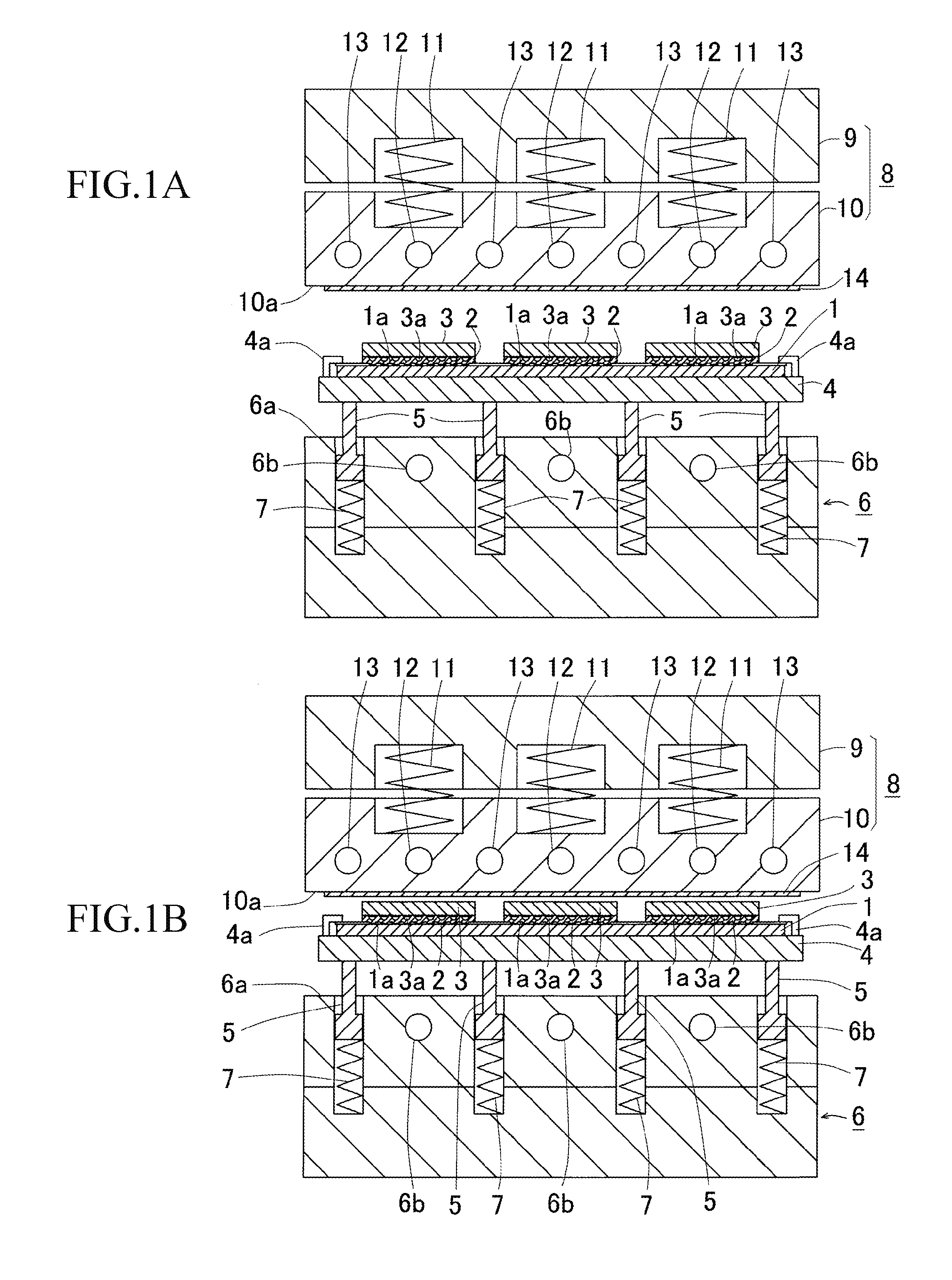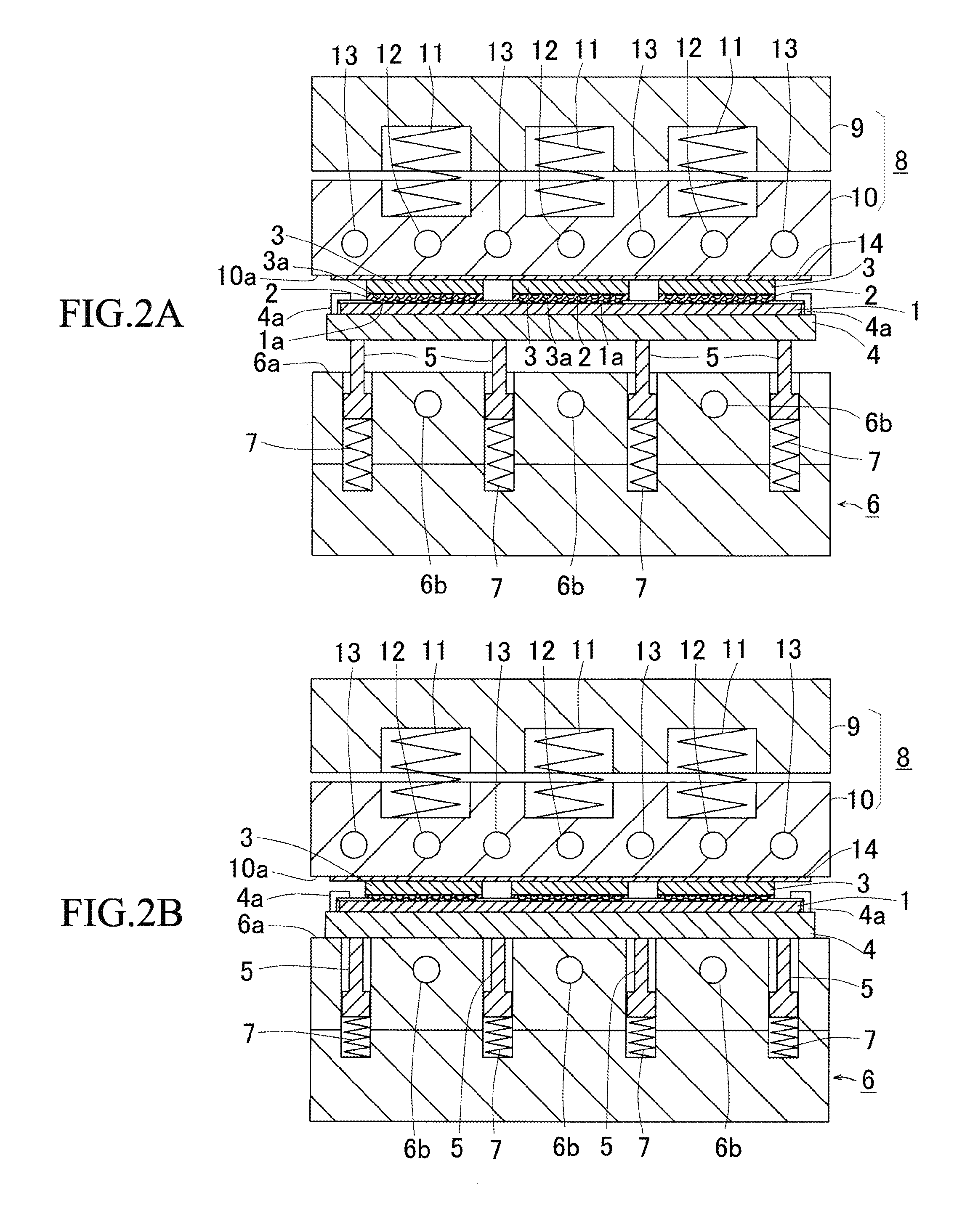Bonding apparatus and bonding method
a technology of bonding apparatus and bonding method, which is applied in the direction of electrical apparatus, chemistry apparatus and processes, and semiconductor devices, etc., can solve problems such as poor connection, and achieve the effects of reducing the thermal capacity of the substrate, improving the reliability of the bonding constructional members of the work, and improving the bonding constructional members
- Summary
- Abstract
- Description
- Claims
- Application Information
AI Technical Summary
Benefits of technology
Problems solved by technology
Method used
Image
Examples
embodiment 1
[0051]Embodiment 1 of the present invention will be explained with reference to FIGS. 1A-2B.
[0052]In FIG. 1A, a substrate 1, on which cable patterns have been formed, has terminal sections 1a, on which semiconductor devices 3, e.g., semiconductor chips, are adhered by a thermosetting non-conductive adhesive 2, e.g., NCF, NCP. The substrate 1, on which the semiconductor devices 3 are adhered, is an organic substrate, but other types of substrates, e.g., inorganic ceramic substrate, may be employed. Further, lead frames, semiconductor wafer, etc. may be employed as the substrate. A plurality of lines and rows of the semiconductor devices 3 are adhered by a known flip-chip bonder (not shown).
[0053]Edges of the substrate 1 are held by chucks 4a, so that the substrate 1 is held by a substrate holding plate 4. A bottom face of the substrate holding plate 4 is supported by a plurality of supporting rods 5 so as to hold the substrate 1 without deformation. As shown in FIG. 1A, the supportin...
embodiment 2
[0071]Next, the apparatus and the method of Embodiment 2 will be explained.
[0072]In comparison with Embodiment 1, the substrate holding plate 4 of the present embodiment has a different structure, and the semiconductor devices 3 are located on the lower side of the substrate 1. Other structural elements of the apparatus of Embodiment 2 are the same as those of Embodiment 1. Therefore, the structural elements described in Embodiment 1 are assigned the same symbols and explanation will be omitted. In the following description, unique structures of Embodiment 2 will be mainly explained.
[0073]In FIG. 4A, supporting sections 4b, whose planar size is slightly smaller than that of the semiconductor devices 3, are upwardly projected from the substrate holding plate 4. Therefore, in the substrate holding plate 4, grooves 4c are formed between the adjacent supporting sections 4b. Edges of the semiconductor devices 3 are not held by the supporting sections 4b, but widths of the edges are small...
embodiment 3
[0081]Next, the apparatus and the method of Embodiment 3 will be explained with reference to FIGS. 6A-7B. Note that, the structural elements described in the above described embodiments are assigned the same symbols and explanation will be omitted.
[0082]In the present embodiment, the substrate 1 is accommodated in a closed space, which is closed by heating / pressing means and supporting means, a reduced-pressure atmosphere or a pressurized atmosphere is produced in the closed space, and then the semiconductor devices 3 are heated and pressed in the closed space.
[0083]As shown in FIG. 6A, a substrate holding plate 15 has an air path 15a and a plurality of sucking holes 15b, which are opened in a surface. An air tube 16a of a sucking mechanism 16, which is provided in a lower die block 19, is connected to the air path 15a. A stretchy spiral tube 16b is provided to a part of the air tube 16a. When the substrate holding plate 15 is pressed by the upper die 8, the spiral tube 16b absorbs ...
PUM
| Property | Measurement | Unit |
|---|---|---|
| temperature | aaaaa | aaaaa |
| temperature | aaaaa | aaaaa |
| melting point | aaaaa | aaaaa |
Abstract
Description
Claims
Application Information
 Login to View More
Login to View More - R&D
- Intellectual Property
- Life Sciences
- Materials
- Tech Scout
- Unparalleled Data Quality
- Higher Quality Content
- 60% Fewer Hallucinations
Browse by: Latest US Patents, China's latest patents, Technical Efficacy Thesaurus, Application Domain, Technology Topic, Popular Technical Reports.
© 2025 PatSnap. All rights reserved.Legal|Privacy policy|Modern Slavery Act Transparency Statement|Sitemap|About US| Contact US: help@patsnap.com



